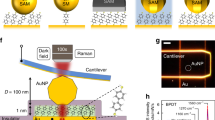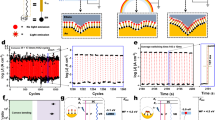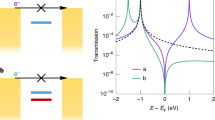Abstract
The ability to control the conductance of single molecules will have a major impact in nanoscale electronics1,2,3,4,5,6,7,8,9,10,11. Azobenzene, a molecule that changes conformation as a result of a trans/cis transition when exposed to radiation, could form the basis of a light-driven molecular switch12,13,14. It is therefore crucial to clarify the electrical transport characteristics of this molecule. Here, we investigate, theoretically, charge transport in a system in which a single azobenzene molecule is attached to two carbon nanotubes. In clear contrast to gold electrodes, the nanotubes can act as true nanoscale electrodes and we show that the low-energy conduction properties of the junction may be dramatically modified by changing the topology of the contacts between the nanotubes and the molecules, and/or the chirality of the nanotubes (that is, zigzag or armchair). We propose experiments to demonstrate controlled electrical switching with nanotube electrodes.
This is a preview of subscription content, access via your institution
Access options
Subscribe to this journal
Receive 12 print issues and online access
$259.00 per year
only $21.58 per issue
Buy this article
- Purchase on Springer Link
- Instant access to full article PDF
Prices may be subject to local taxes which are calculated during checkout




Similar content being viewed by others
References
Joachim, C. & Ratner, M. A. Molecular electronics: some views on transport junctions and beyond. Proc. Natl Acad. Sci. USA 102, 8801–8808 (2005).
Visoly-Fisher, I. et al. Conductance of a biomolecular wire. Proc. Natl Acad. Sci. USA 103, 8686–8690 (2006).
Champagne, A. R., Pasupathy, A. N. & Ralph, D. C. Mechanically adjustable and electrically gated single-molecule transistors. Nano Lett. 5, 305–308 (2005).
Donhauser, Z. J. et al. Conductance switching in single molecules through conformational changes. Science 292, 2303–2307 (2001).
Lastapis, M. et al. Picometer-scale electronic control of molecular dynamics inside a single molecule. Science 308, 1000–1003 (2005).
Wu, S. W., Nazin, G., Chen, X., Qiu, X. H. & Ho, W. Control of relative tunneling rates in single molecule bipolar electron transport. Phys. Rev. Lett. 93, 236802 (2004).
Elbing, M. et al. A single-molecule diode. Proc. Natl Acad. Sci. USA 102, 8815–8820 (2005).
Zhirnov, V. V. & Cavin, R. K. Molecular electronics: chemistry of molecules or physics of contacts? Nature Mater. 5, 11–12 (2006).
Choi, B.-Y. et al. Conformational molecular switch of the azobenzene molecule: a scanning tunneling microscopy study. Phys. Rev. Lett. 96, 156106 (2006).
Moresco, F. et al. Conformational changes of single molecules induced by scanning tunneling microscopy manipulation: a route to molecular switching. Phys. Rev. Lett. 86, 672–675 (2001).
Dulić, D. et al. One-way optoelectronic switching of photochromic molecules on gold. Phys. Rev. Lett. 91, 207402 (2003).
Hugel, T. et al. Single-molecule optomechanical cycle. Science 296, 1103–1106 (2002).
Zhang, C. et al. Coherent electron transport through an azobenzene molecule: a light-driven molecular switch. Phys. Rev. Lett. 92, 158301 (2004).
Zhang, C. et al. Current-voltage characteristics through a single light-sensitive molecule. Phys. Rev. B 73, 125445 (2006).
Guo, X. et al. Covalently bridging gaps in single-walled carbon nanotubes with conducting molecules. Science 311, 356–359 (2006).
Venkataraman L. et al. Single-molecule circuits with well-defined molecular conductance. Nano Lett. 6, 458–462 (2006).
Kobayashi, Y., Fukui, K., Enoki, T., Kusakabe, K. & Kaburagi, Y. Observation of zigzag and armchair edges of graphite using scanning tunneling microscopy and spectroscopy. Phys. Rev. B 71, 193406 (2005).
Aviram, A. & Ratner, M. A. Molecular rectifiers. Chem. Phys. Lett. 29, 277–280 (1974).
Cumings, J. & Zettl, A. Low-friction nanoscale linear bearing realized from multiwall carbon nanotubes. Science 289, 602–604 (2000).
Kwon, Y.-K., Berber, S. & Tománek, D. Thermal contraction of carbon fullerenes and nanotubes. Phys. Rev. Lett. 92, 015901 (2004).
Frauenheim, T. et al. A self-consistent charge density-functional based tight-binding method for predictive materials simulations in physics, chemistry and biology. Phys. Stat. Sol. B 217, 41–62 (2000).
Pecchia, A. & Carlo, A. D. Atomistic theory of transport in organic and inorganic nanostructures. Rep. Prog. Phys. 67, 1497–1561 (2004).
Fisher, D. S. & Lee, P. A. Relation between conductivity and transmission matrix. Phys. Rev. B 23, 6851–6854 (1981).
Cuniberti, G., Grossmann, F. & Gutíerrez, R. The role of contacts in molecular electronics. Adv. Solid State Phys. 42, 133–149 (2002).
Acknowledgements
We thank A. Holleitner for making us aware of the details of the experiments being performed with azobenzene, and N. Nemec, D. Tomanek and R. de Vivie-Riedle for discussions and suggestions. This work was funded by the Volkswagen Foundation under grant No. I/78 340, by the DFG Priority Program “Quantum Transport at the Molecular Scale” SPP1243, by the MEC under contracts MAT2005-01388, NAN2004-09109-CO4-04, by the CAM under contract No. S-0505/ESP-0200, and by the European Union project “Carbon nanotube devices at the quantum limit” (CARDEQ) under contract No. IST-021285-2. M.d.V. acknowledges the support from the FPI Program of the Comunidad Autónoma de Madrid.
Author information
Authors and Affiliations
Corresponding author
Ethics declarations
Competing interests
The authors declare no competing financial interests.
Supplementary information
Supplementary Information
Supplementary figure S1 (PDF 637 kb)
Rights and permissions
About this article
Cite this article
del Valle, M., Gutiérrez, R., Tejedor, C. et al. Tuning the conductance of a molecular switch. Nature Nanotech 2, 176–179 (2007). https://doi.org/10.1038/nnano.2007.38
Received:
Accepted:
Published:
Issue Date:
DOI: https://doi.org/10.1038/nnano.2007.38
This article is cited by
-
Design of Novel Molecular Switches Using the C20 Fullerene: A DFT Study
Journal of Cluster Science (2023)
-
Coupling carbon nanomaterials with photochromic molecules for the generation of optically responsive materials
Nature Communications (2016)
-
Density Functional Theory for Steady-State Nonequilibrium Molecular Junctions
Scientific Reports (2015)
-
Conductivity of carbon-based molecular junctions from ab-initio methods
Frontiers of Physics (2014)
-
Switching the conductance of a molecular junction using a proton transfer reaction
Journal of Molecular Modeling (2014)



